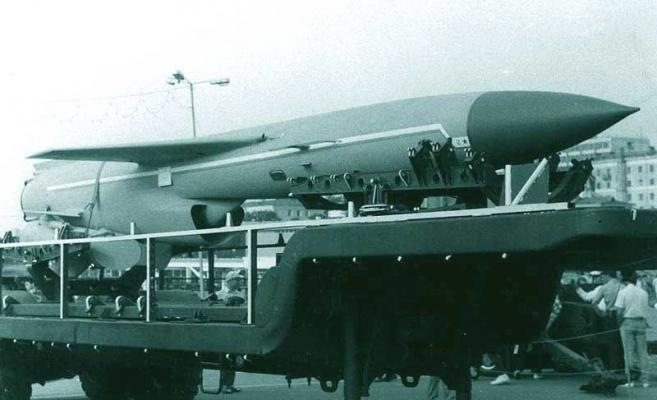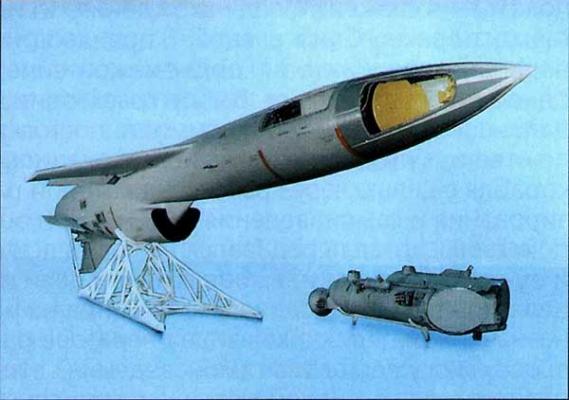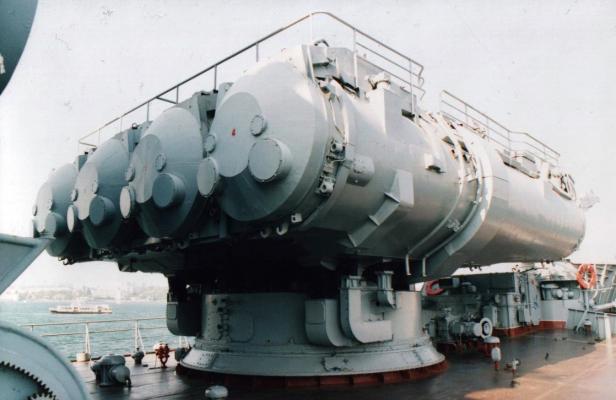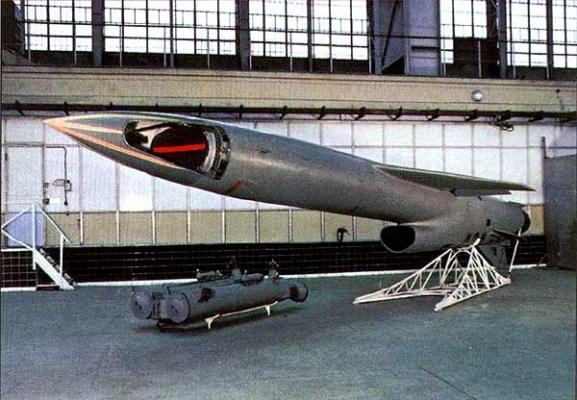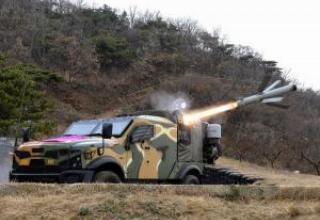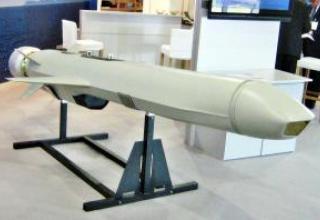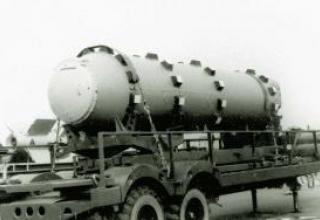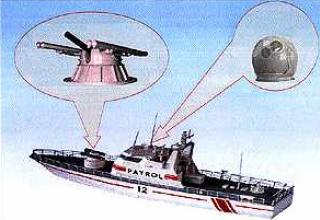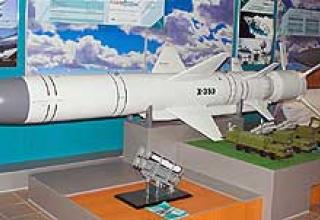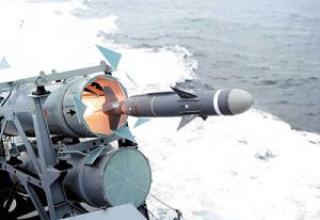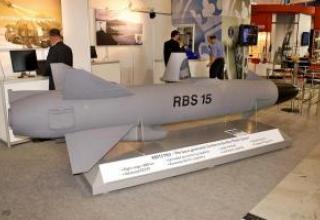August 17, 1956 was issued CM CCCH Resolution № 1149-592 on the beginning of development of anti-ship cruise missiles P-6 and P-35. Both missiles were designed in OKB-52 and differed little from each other. P-6 was designed for submarines, while P-35 was designed for surface ships.
The launchers for P-35 SM-70, SM-82 and SME-142 were designed by the Central Design Bureau-34 together with the Central Research Institute-173 (guidance drives), and were manufactured at the Bolshevik plant. The task to develop a standard launch unit SM-70 for cruisers of Project 58 was given to the Central Design Bureau-34 in December 1956. Four-container launcher SM-82 was intended for ground testing of the complex, and single-container launcher SME-142 was intended for testing on pilot ship OS-15 (re-equipped in 1959 dry cargo ship "Ileti").
The first launch of the P-35 missile took place on October 21, 1959. In parallel with the P-35 tests, the completion of cruisers of Project 58 was underway. The first ship of Project 58 "Grozny" was laid down on February 23, 1960 and launched on March 26, 1961. In the same year the first 2 quadruple guided missile launchers SM-70 were mounted on it. In total, the plant was equipped with the first 2 quadruple inducing launchers of SM-70. Four cruisers of project 58 ("Grozny", "Admiral Fokin", "Admiral Golovko" and "Varyag") were built in Leningrad. In 1964-1968 at the same plant were laid four large anti-submarine project 1134 ("Admiral Zozula", "Vladivostok", "Vice-Admiral Thrush" and "Sevastopol"). Project 1134 ships were armed with P-35 missiles installed in two twin KT-35 launchers. The launchers did not have a swivel mechanism and were guided by turning the ship's hull. The project provided for the placement of four spare missiles in the cellars on the upper deck. However, during the construction of the ships, the reloading of the missiles was refused.
Testing of the P-6 missile began on December 23, 1959. Resolution of the CM dated June 23, 1964 P-6 complex was adopted for service of diesel submarines of project 651 and nuclear project 675. The main armament of the submarine - eight cruise missiles P-6 (4K88) - were placed in containers, rising to the starting position at an angle of 14 °. Shooting was possible only in the surface position.
On the basis of P-35 missile in 1966 was created coastal complex "Redoubt".
Composition:
Structurally, the P-6/P-35 missiles (see diagram) represented further development of the P-5 anti-ship missile. The missiles had identical aerodynamic schemes, launch accelerators and launch containers. The Antey control system was prepared by NII-49 of the Ministry of Shipbuilding Industry.
The missiles were equipped with a 4G-48 high-explosive explosive reactive armament (weighing 800-1000 kg) developed at NII-6, or a special combat unit.
The missiles flew in the "high altitude - low altitude" mode. The high altitude of the flight was required to ensure direct radar contact between the carrier and the missile up to detection of targets by the missile's homing radar head. The radar image was then broadcast to the carrier, where the operator officer selected the targets (i.e. he chose the most important one, for example, an aircraft carrier in an aircraft carrier warrant). After that, a command to capture the selected target was sent to the radar visions of the missile. On this mode of remote control ended, and the missile was lowered to a low altitude, without losing radar contact with the captured target and carrying out homing on it at a rate. In the final section, the missile would dive to the target, but the combat unit would not detach.
At the same time, P-6/P-35 missiles could also be fired in autonomous mode without the use of telecontrol lines and target image transmission channels. In this case, it was possible to salvo all the ship's launchers.
The P-35 (4K44) missile had several flight modes at altitudes from 400m and almost 7.5km. Depending on the altitude mode, the flight speed and range (approximately from 100 to 300 km) were changed. Interestingly, the P-35 could also be used for firing at ground targets, for which it was only necessary to switch the onboard control system "Block" from mode "M" (sea) to mode "B" (coastal). In this case, the missile on command from the cruiser dive to the target at an angle of 80 °.
The horizontal pointing angle of the CM-70 cruisers of Project 58 (see photo) was 120°, the starting angle was 25°. Ammunition for each unit consisted of 8 P-35 missiles, of which 4 were directly in the containers of the launcher, and another 4 - in the cellar, next to the installation. Usually, one of the four P-35 missiles had a special 20 kt combat unit.
Attacking surface ships at distances many times greater than the range of direct radar visibility, required the creation of intelligence and target designation system for anti-ship missiles. The "Success" aviation reconnaissance system was created by the Kyiv Research Institute of Radio Electronics (nowadays, NPO "Kvant") under the supervision of Chief Designer I.V. Kudryavtsev. It consisted of an airborne radar complex for detection of surface targets and radar information transmission equipment, placed on Tu-16RC, Tu-95RC aircraft (later on Ka-25RC helicopters) and on ships. The airplanes were used to deploy an aviation radar system for detecting sea targets and transmitting signals to ships, where data was processed and target designation was given to the missile system. In the system of reconnaissance and target designation, adopted in service in 1965, for the first time was carried out transfer from a reconnaissance aircraft to the ship carrier anti-ship missiles radar image of the inspection area in real time. Thus, in the USSR, for the first time in the world, a reconnaissance strike system (RUS) was created, which included reconnaissance equipment, strike weapons and their carriers (both sea and air). Long range Tu-95RC allowed to conduct reconnaissance of ships at sea and perform the task of target designation at a range of up to 7000 km.
The use of the reconnaissance and strike system was as follows: a submarine located in a given area, after receiving a military order for the use of missile weapons, floated to the periscope depth and established a link with the reconnaissance and target designation aircraft, which transmitted radar information on surface targets to the PL. This information was displayed on the screens of the operator's console of the boat's target designation system. The ship's commander analyzed the target situation and assigned a target on which to determine the coordinates (bearing and range). These data were then entered into the ship's missile control system, the weapon reach was assessed and the expected probability of detecting the target by the missile's radar sighting system. Based on this information, the final decision on firing was made. The boat was placed on a combat course, performing prelaunch training, after which it floated to the surface position and produced a rocket salvo (the number of PCRs in a salvo is no more than four).
The flight of each rocket in the salvo relative to the firing plane was controlled by one operator at the bearing mark on the radar indicator. In case of deviation of the bearing mark on the given direction, the operator returned the SKR to the firing plane. When the missile reached the calculated range (developed by the ship's control system), on command of the operators, the missile's radar payloads and radio channel transmitters were switched on to transmit the information received by the payloads. After the target was captured by the PKR radar sighting system, on the command of the operator, it was switched into the homing mode (initially the missile was homing only in the horizontal plane, then carried out its gentle diving and a few kilometers before the target was introduced and the homing mode in the vertical plane).
On the 675-th PL project for the first time in the world was realized the possibility of multiple launch rocket fire with selective defeat of enemy ships that are part of the compounds. The nuclear-powered ship could carry out a four-missile salvo within 15 minutes, two salvo - within 20-30 minutes, taking into account the time spent on the surfacing, preparation for launch, launch and flight of missiles to the target. It was possible to simultaneously fire 12 P-6 missiles from different carriers at the target, which made it possible to overcome the tightest air defense of aircraft-bearing compounds of the 60s.
Project 675 boats were among the most actively upgraded ships of the Soviet fleet. This was largely due to the rapid improvement of their main opponent, the US Navy aircraft carriers. P-6M missiles were upgraded to the P-6M (4K48) version. Since 1959, the Research Institute-49 under the leadership of A.P. Tsvetkov has been working on the creation of the "Lightning" station, which provides autonomous zagorizonnoe target designation by using the phenomenon of tropospheric dispersion of microwave radio waves. In December 1969, the station "Lightning" was adopted by the Navy for installation on the PL 675 project, as well as diesel boats project 651.
A significant drawback of the P-6 complex was a surface start. At the same time, the time of staying of the submarine with the P-6 complex increased in comparison with the boats with the P-5 complex on board, because now it was necessary to control from the ship and the flight of the missile up to the capture of its target GSN. Despite this obvious disadvantage, the P-6 system gave the Soviet fleet tangible advantages in the fight against large enemy surface ships.
Characteristics:
| Maximum range of fire, km | up to 400 |
| Flying speed march, M | 1.5 |
| The marching altitude of the rocket flight, m | 400 / 4000 / 7000 |
| Flight height at the end section, m. | 100 |
| Dimensions, m: | |
| - length | 10 |
| - wingspan | 2,6 |
| - folding width | 1,544 |
| - max. housing diameter | 1,0 |
| - altitude | 1,5 |
| Mass of empty rocket, kg | 2330 |
| Launch mass of the rocket, kg. | 4 500 |
| Fighting unit | blast |
| Weight BC, kg | 800- 1000 |
| The power of the nuclear BC, kT | 350 |
| Governing bodies | airfoils |
| Marshal engine | TRD 4D48 |
| Fuel | kerosene |
| Starter motor | two RDTTs |
| Traction, kgs. | 2 х 30 000 |
| Start engine running time, s | 2 |
Testing:
Tests on a P-6 missile. The first stage of flight tests was conducted on site 4A near Balaklava from December 23, 1959 to July 1960. A total of 5 launches of missiles without radio equipment. In general, the tests were successful. The second stage of flight tests P-6 was held from July to December 1960 at the Northern testing ground near the village of Nenoksa, 30 km west of Severodvinsk in the Dvinskaya Bay. The launches were made from a shore stationary container and then from a rocking container. There were 6 launches in total and the results were unsatisfactory due to failures of the Antey control system. After finalization of the control system till December 6, 1961 7 more launches of P-6 missiles were made.
The first stage of joint flight tests was held from May to December 1962 in Nenoks from the rocking stand. Of the thirteen launches, seven were fully successful. In 1962, from 22 to 25 July in the Northern Fleet near Severodvinsk held an event "Kasatka", during which the top leadership of the country demonstrated the launches of ship rockets P-5D, P-35 and P-6. The second stage of joint flight tests P-6 was held from July to October 1963 on the submarine 675U project. A total of five launches were made, two of which were direct hits on the target that sank. The third stage of joint flight tests was conducted from October to December 1963. Three successful launches were made from Project 651 and nine from Project 675, of which seven were direct hits.
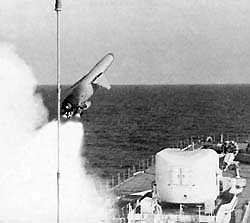
Tests of the P-35 missile. The tests on the pilot ship OS-15 were conducted on the Caspian Sea at the testing ground near Krasnovodsk. The first launch took place on July 27, 1960. The first series of seven launches gave unsatisfactory results and required improvement of the APLI-1 control system.
Subsequent flight tests from the 4th quarter of 1962 were more successful. A number of launches were made against targets: the unfinished leader of the project 48 "Kiev" squadron of mine carriers and the tanker "Nizami". One missile, with an inert warhead (without explosives), was enough to sink the leader with displacement of 2500 tons. The rocket hit the left cheekbone, opened the deck like a tin can about 50 m long, then the rocket crashed, and its engine broke through the bottom, and after 3 minutes the leader sank.
Sources:
- И.Л. Баранов "История создания и перспективы развития отечественных подводных лодок с крылатыми ракетами". "Судостроение" №2 2001 г.
- А.Б.Широкорад "Оружие отечественного флота" , Минск, Харвест, 2001г.
